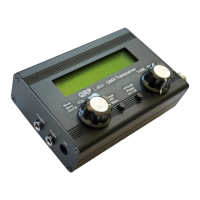Next click the “Radio” tab in the settings window, which sets up the CAT control communication.
The following four settings need to be changed, and are illustrated in the diagram below:
• Rig will be set to None by default, click the drop down and choose “Kenwood TS-440”
which should work well with QMX. On some other software, if you find that TS-440 is not
present in the list or does not work properly, you could try “Kenwood TS-480”. More details
about CAT and debugging any CAT problems are in another section of this manual, where
the CAT test terminal screen is described.
• The Serial Port drop-down must be set to the correct port where QMX is connected.
On my Linux system it is either “/dev/ttyACM0 or /dev/ttyACM1. On Linux you can also
access a serial port via its unique device name, which will be: “/dev/serial/by-id/usb-
QRP_Labs_QMX_Transceiver-if00”. This doesn’t change depending on which other
devices are connected.
On Windows systems it will be a COM port numbered COM1, COM2 etc.
Unfortunately unlike the USB Sound, the serial port name doesn’t contain the text “QMX”. If
you are unsure which port to choose for QMX, the easy way to find this is as follows.
Unplug QMX. Restart WSJT-X. Look in Settings -> Radio and make a note of the list of
serial devices. None of these are QMX (because you unplugged it). Now close WSJT-X,
plug in QMX, start WSJT-X and again look in Settings -> Radio, and now you should see a
newcomer in the list of available ports. The newcomer is QMX!
• Note that none of the Serial Port Parameters need to be changed, leave them all at their
defaults. Even the baud rate 9600 is unimportant because it is irrelevant to the USB Virtual
COM Port which is a virtual port over USB, not a real physical serial port.
• Change the Poll Interval to 10 seconds, the default will be rather chatty with QMX which
probably is not a problem, but anyway I feel more comfortable with the less frequent polling.
QMX has no capability to alter its operating frequency for example by itself, it can only do
so at the command of WSJT-X over CAT; therefore the polling is actually redundant
anyway.
• Change PTT Method from the default “VOX” to “CAT”. VOX means “voice operated
exchange” or “voice activated transmission”; the radio will automatically switch to transmit,
when incoming audio is detected. With PTT Method set to CAT, when WSJT-X wishes to
start a transmission, it will send an actual CAT command to QMX informing it to start the
transmission, before sending the audio. This CAT command causes QMX to switch from
Receive mode to Transmit mode (and back again afterwards). “CAT” is preferable to “VOX”
because if system sounds are accidentally routed to your “QMX” sound card as output, then
with VOX that will enable the QMX transmitter and try to transmit the sound.
• Now click the “Test CAT” button and after a few seconds, it should turn Green to indicate
successful communication with QMX.
QMX operang manual; rmware 1_00_012 51

